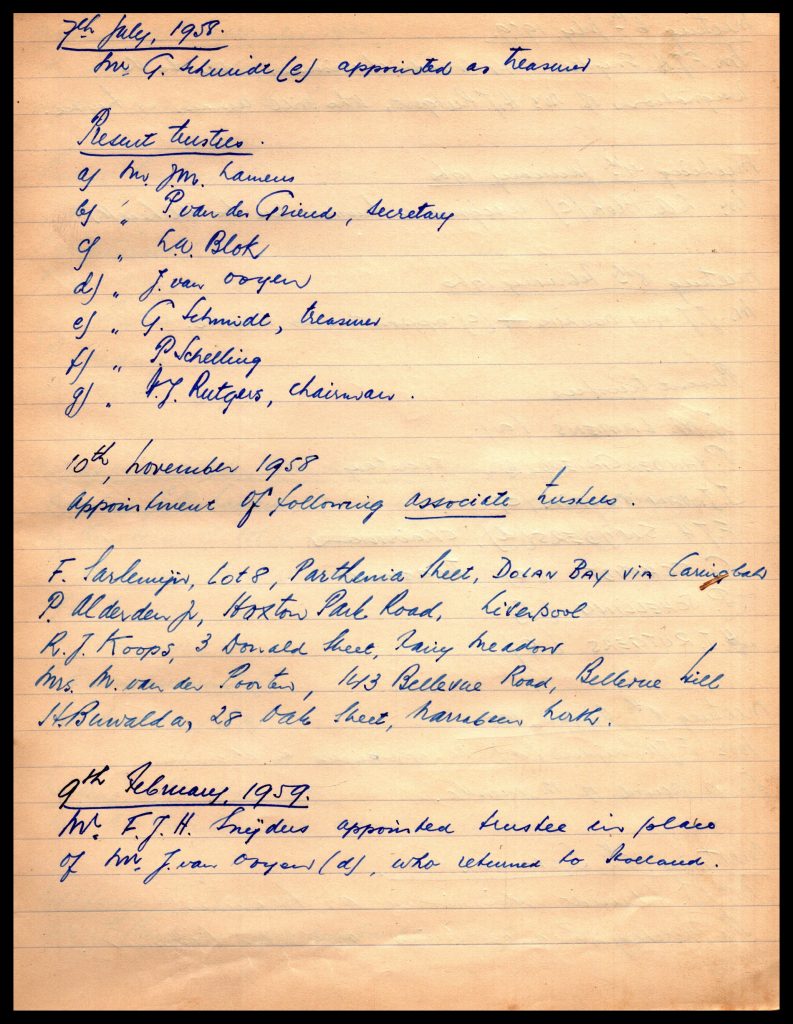Established in 1903 to support sailors who had jumped ship
Established as the Queen Wilhelmina Benevolent Trust Fund, it was established in 1903 to support Dutch sailors who found themselves in need of financial assistance after jumping ship in foreign ports. At the time, many Dutch sailors were facing difficult working conditions and low wages, and some chose to jump ship and try to make a better life for themselves in foreign countries. Several sailors jumped ship in Australia lured by the gold rush in the 1850s and 1860s.
The Fund was named after Queen Wilhelmina, who was the queen of the Netherlands at the time. It was initially established with a donation of 10,000 guilders from the Queen’s personal funds, and it quickly received support from other individuals and organisations.
The primary goal of the Fund was to provide financial assistance to Dutch sailors who found themselves in need. This assistance could take many forms, including food, clothing, shelter, and medical care. The Fund also provided support for the families of sailors who had died or been injured while working at sea.
Over time, the focus of the Fund shifted somewhat, and it began to provide support to other groups in need, including refugees and victims of natural disasters. However, its commitment to helping Dutch sailors who found themselves in difficult circumstances remained a core part of its mission.
Queen Wilhelmina Benevolent Trust Fund and the Marshall Plan (post WWII)
After WWII the Queen Wilhelmina Benevolent Trust Fund continued to provide support to those in need, both in the Netherlands and abroad. Its long history of helping those who have fallen on hard times has made it a respected and valued institution in Dutch society.

Learning from the lessons of WWI, after WWII a massive reconstruction plan was developed for the reconstruction of Europe. In 1947 the US launched the Marshall Plan, over the next 4 years they distributed $13 billion of aid to 19 countries in Europe (including Germany).
The Netherlands received $1,127 billion one of the highest per capita ($109). A significant proportion of the money was used for housing development (eg Nijmegen and Rotterdam).
And here lays the link with Australia. Immigration was an important policy after the war, but many immigrants did not have enough money to buy or build their own house. For this purpose The Dutch Immigration Service set up a number of Building Societies in various states, aimed to assist Dutch immigrants, providing them with affordable housing. Tradition has it that money from the Marshall Plan was also used to set up the Building Societies.
These Dutch building societies functioned for many years. People had to become a member and make contributions before being eligible for a loan.
The following are the registers of the Trustees of the Queen Wilhelmina Benevolent Fund Between 1956 and 1982.










Below are the minutes of the QWBF from March 10 1980, which also mentions the resignation of its Chairman Henk Rutgers.

The (small) Dutch Building Societies were managed by various (Dutch) managers. To supplement their income , they received the benefit of the commissions( from the insurance companies) of the building insurance sold with the loans.
When commercial banks started to make mortgage loans available at a large scale, they became superfluous and closed down in the 1970’s.
In the DAW below see page 12 for an article on the Building Societies.
The “future payments” of the commissions were bought out by the insurers and this capital formed the funding of The Netherlands Benevolent Trust Fund. (NBTF) The constitution stated that the three ex-managers of the Building Societies would have 60% benefit of the interest earnings of the fund until their death. The rest was to be distributed to organisations with charity status.
Charity organisations had to apply each year. There were usually only 3 incoming applications. For example, from the Queen Wilhelmina Benevolent Fund (NSW), Dutch Care (Vic) and DACA (Qld). All were usually successful in their applications. As the source of capital varied in size from the three states, the benefits were also distributed according to the size of the original input of capital in the Fund. NSW and Victoria received each approx. 40% of the money and Queensland 10%.
The charity organisations where further funded by donations from Dutch (multinational) companies and individuals.
The three managers (and their widows) lived long after their retirement. Eventually when only one manager was still alive, the trustees managed to persuade this person to buy out his future benefits. This gave the NBTF a chance to transfer the remainder of the capital to the three charities and close the Fund down.
Robert van der Vegt was one of the founding trustees and served for about 40 years until the Fund closed down.
The Queen Wilhelmina Fund merged around 2000 with the NBTF and was renamed: The Queen Wilhelmina Dutch Benevolent Trust Fund. To signify the history of the fund. The Fund was used for social assistance to Dutch immigrant families in Australia.The annual trustee meetings were held at the house of the Consul General of the Netherlands is Sydney.

The following text is from a booklet published by the Federation of Netherlands Societies Ltd. in February 1985. The research for this booklet was done by Mijntje Hage.
Some of the historic archives, including minutes of the meetings and annual accounts, are now at the State Library of New South Wales.
See also: The Federation of Netherlands Organisations in Queensland
Some of the information on the Netherlands Benevolent Trust Fund (period 1978 – 2006) in the DACC’s paper-based archives.


